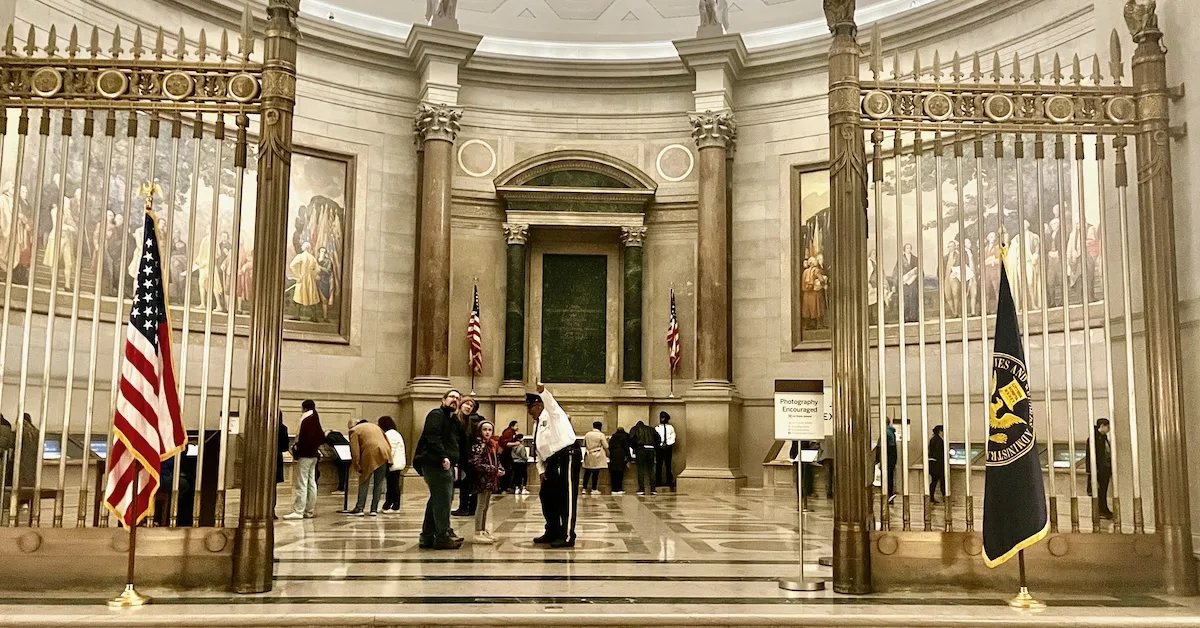We’ve visited Washington, DC many times as our daughter has grown up and have had the chance to rediscover the city several times over as she’s reached different ages.
On our first trip with a preschooler, the big hits were the mall’s carousel and a food truck that sold chicken and waffles. On our latest visit, the city’s many used book stores and Library of Congress captured our teen’s attention. And she still likes food trucks.
We’ve explored must-see sites like the Vietnam Memorial (best with teens) and the free and excellent Smithsonian Zoo (great for youngsters), and we’ve found off-the-beaten track things to do, like kayaking on the Potomac.
Here, organized roughly by age group, are some of the coolest things to do, places to eat and places to stay in Washington, DC with kids.
Read More
• Family Weekend Fun at National Harbor
• My review of the Gaylord Hotel, National Harbor
• Great Things To Do and To Eat in Baltimore with Kids
• This article is featured on GPSmyCity. To download it or offline reading or create a self-guided walking tour, go to Walking Tours and Articles in Washington, DC. Or read it in the app.
Washington, DC Hotels
We’ve stayed in a different hotel every time we’ve come to Washington. Sometimes we want to be in different parts of the city to be close to certain things, but often because I’m looking for the best value or trying to make the most of our hotel points.
I always like to be near a Metro station so we don’t have to deal with all the crazy parking restrictions around the mall. And we like having breakfast and dinner spots we can walk to.
• On our latest visit, we booked the Embassy Suites Georgetown, mostly for its proximity to several DC college. It’s probably my favorite of the several DC-area hotels we’ve stayed in.
The living and sleeping areas in our suite were separated by the bathroom, and we had a lot of room to spread out. On night after dinner, I sat reading in the living room while Teen Traveler did homework in the bedroom. There was a microwave, fridge and bar sink, too.
The large breakfast buffet had cooked-to-order eggs, fresh baked goods and lots of other options as well. We stopped at the bar/lounge area twice after dinner to have a molten chocolate cake and drinks for dessert.
The pool was chilly, but there was a hot tub, which is unusual for Hilton and very welcome during our chilly February stay.
We were a five-minute walk from the Dupont Circle Metro Station and within walking distance of several good places to eat.
Tip: When we pulled up to check in on a Saturday, a staff member told me that meters are not in effect on the weekends and pointed out a spot that was available on the street. I had to pop out (in my pajamas) at 7:00 AM on Monday to put money in the meter for a couple of hours until we checked out. But it was more than worth it to save $140 for two days of parking in the garage.
• On the previous visit, we stayed at West End Tapestry Collection by Hilton, which is in the same neighborhood as the Embassy Suites. But its smaller and the amenities were minimal.
The room had space for three people to spread out, with a kitchen and small living area, which is the most important thing. While it didn’t have its own garage, we had come-and-go parking available to us at a hotel around the corner.
It was walking distance from the Foggy Bottom metro station and Dupont Circle restaurants. It suited our purposes during a weekend where we were barely in the hotel, but I’m more likely to return to the Embassy Suites.
• During a late June visit, we booked the Westin Georgetown, which is closer to Georgetown than the Tapestry and about the same distance from the Foggy Bottom Metro.
The rooms are standard size, but they have deep bathtubs that are separate from the walk-in shower, a handy extra with small kids.
The main attraction for us, though, was the rooftop pool, which was handy on those hot DC-summer days. There was a breakfast buffet available but we passed it up in favor of more casual options nearby.
• Read my Tips for finding good Washington, DC hotel deals for more lodging ideas.
My Top Washington, DC Family Activities By Age
Best With Teens & Tweens
Kayaking on the Potomac
A wonderful company called Boating in DC has several boat houses around the city rent kayaks, canoes, stand-up paddle boards and, in select places, row boats and pedal boats.
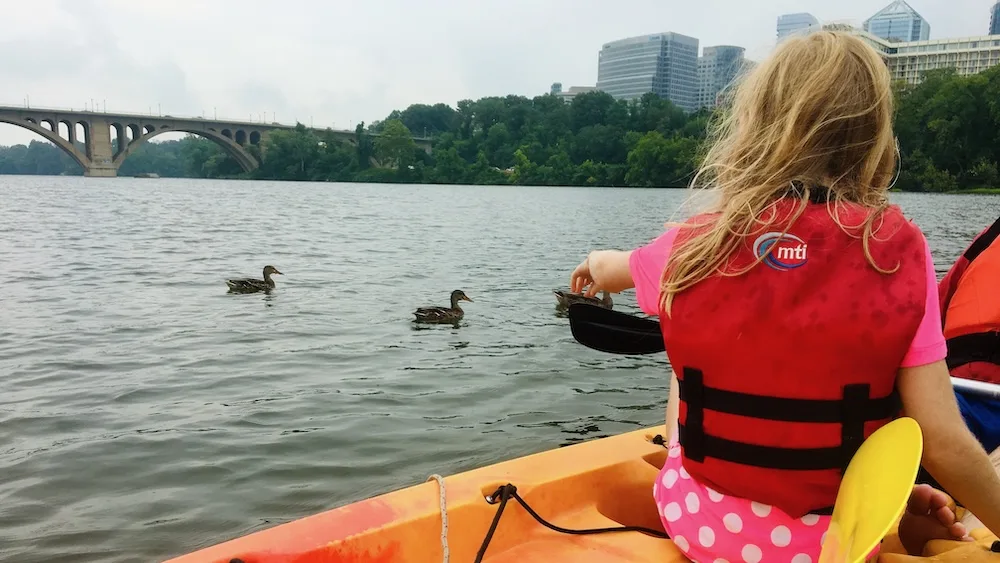
We decided to push off in kayaks from their Key Bridge location during one of our summer visits. They didn’t have any double kayaks available so they let Tiny Traveler perch on the front of one of the two single-person kayaks we rented and we set off up river.
We looked up at the spires of Georgetown University and saw a deer munching on leaves on shore. We spotted a large strange bird on one of the rock outcrops, passed a kayaker fishing and saw some SUPers swimming. Tiny Traveler got out to climb on the rocks before we headed back down river. At one point, a group of ducks surrounded us, probably looking for food.
It’s probably nice in the fall, too, when you can spot changing foliage and in the spring when things are in bloom. The best views of Georgetown are probably when there are no leaves on the trees.
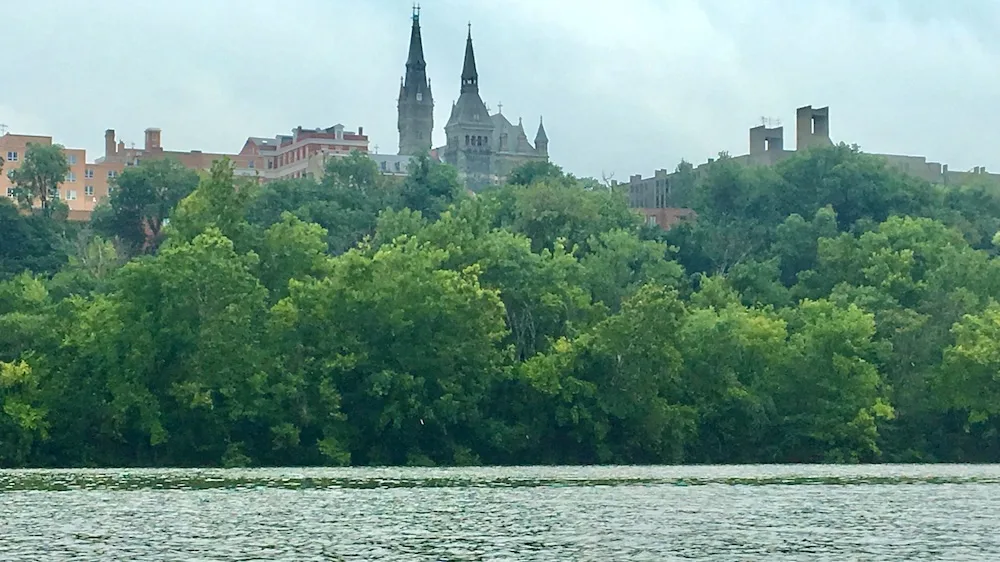
Teens can easily manage their own kayaks. Even though they’ll let kids 8YO and paddle on their own, I’d probably share a kayak with kids and tweens, unless they had kayaking experience. And until they’re tweens I’d plan on doing most of the work.
Tweens can usually handle SUPs fairly easily.
Tip: Most of the locations have street parking and lockers for shoes and extra clothes, but not necessarily a place to change. I recommend wearing quick-dry tops and bottoms, tankinis or swim shorts.
Planet Word Museum
We headed to this free, non-Smithsonian museum that celebrates language and words because one of Teen Traveler’s friends recommended it. It’s like no museum we’ve ever been to and was very cool.
Be sure to take the elevators, which have be turned into compact libraries.
On the top floor, we tracked the evolution of English across a giant wall of words, and went into a room where we could activate any of several small screens to learn basic words in dozens of languages.
On the second floor, we tried to crack each other up with a series of corny jokes. We also dipped a “paint brush” into words like verdant, surreal, day or night and painted a mural with them, triggering changes in the sights and sounds of giant pictures. This was super cool and the most kid-friendly attraction.
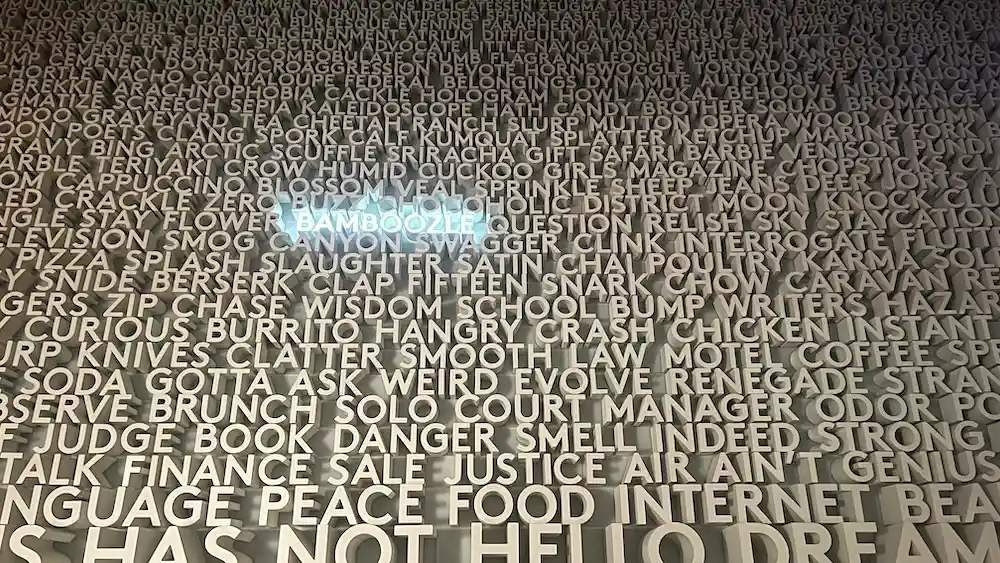
Two other rooms explained the cadence of words and uses of literary devices to make songs catchy and speeches memorable. In another one, we made books come to life.
We ran out of time before we got to the first floor. We’ll will go back again the next time we’re in Washington.
Tip: The museum is proving to be popular. It was pretty busy when we got there late on a Saturday afternoon. You can reserve your free tickets in advance and you’ll save some time if you do.
The Bureau of Printing and Engraving
Find out how the government makes money – literally. On the free 45-minute tour, we got to watch greenbacks being printed, inspected, counted and stacked into huge pallets.
I’d say this is something that is best for tweens and teens who appreciate money enough to enjoy learning how it’s made and who might be interested in the technology and anti-forgery innovations that go into designing the bills.
Tours are free and on weekdays only (no tours on federal holidays). You don’t need tickets from September to March. During the spring and summer, go to the Visitors Center on 14th St SW first thing in the morning to get tickets.
On a June day, I arrived at 9:30 a.m. and the first tour available was at 12:45 p.m.
The Library of Congress
I was not prepared for how stunningly beautiful the Library of Congress is.
Give your family a good 90 minutes to two hours to explore everything there is to see throughout the building. There is an audio tour that is concise and well done. And you can listen or skim a transcript of it.
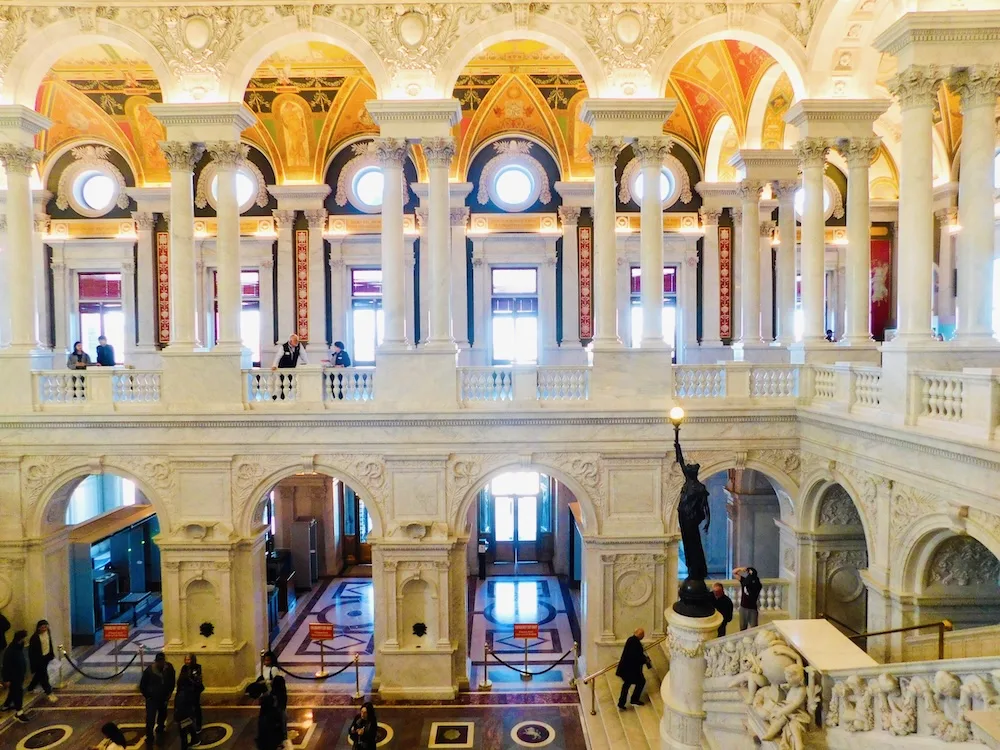
After you’ve gaped at the Great Hall and check out the Library’s Gutenberg Bible and then move on to gape more at the oval main reading room.
The reading room was built during the Gilded Age and its many decorative details celebrate education, science, the arts and reading. As such, it’s wonderful.
Tip: They close the reading room from 1130 AM to 2:00 PM every day. If you do a morning tour, watch the time and make sure to stop in before it closes.
Head upstairs, pausing to admire the Minerva mosaic and then go to the reading room’s overlook to get a closer look at the science-themed ceiling and to appreciate the room’s unique layout from above.
From here you can see some of the collections, including Thomas Jefferson’s library and a small exhibit on the great American composers, George and Ira Gershwin.
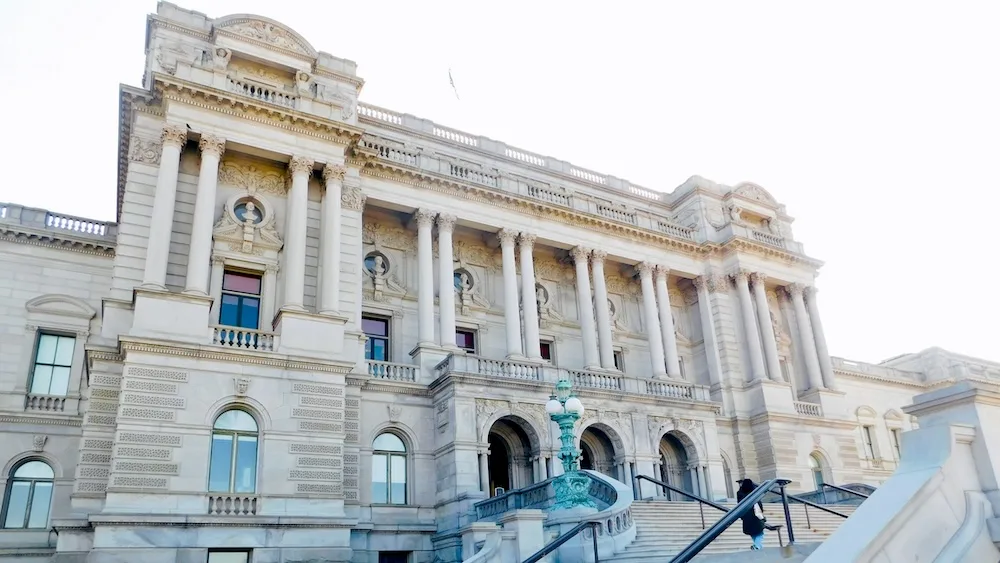
There are also rotating exhibitions that are pulled from the library’s vast archives. We got to see more than 150 years of photos that trace the evolution of both photography and American culture. I love good journalistic photography and really enjoyed this.
Tip: It’s free to visit the Library of Congress but you need timed tickets and it’s a best to get these ahead. It was packed when we visited during our February break, which I didn’t mind. It’s reassuring to me that so many families visiting Washington, DC are clamoring to visit a library.
Visitors have to pass through airport style security. There is always a line for the first couple of entry times. Once the line gets moving, it goes quickly and you’ll wait less for the tours after 10:45 or so.
The National Archives
We like to say that our Constitution is a living document, so why not visit it when you are in town?
Make sure to pause on the ground floor. You’ll find a copy of the British Magna Carta and a thought-provoking history of the evolution of civil rights in America.
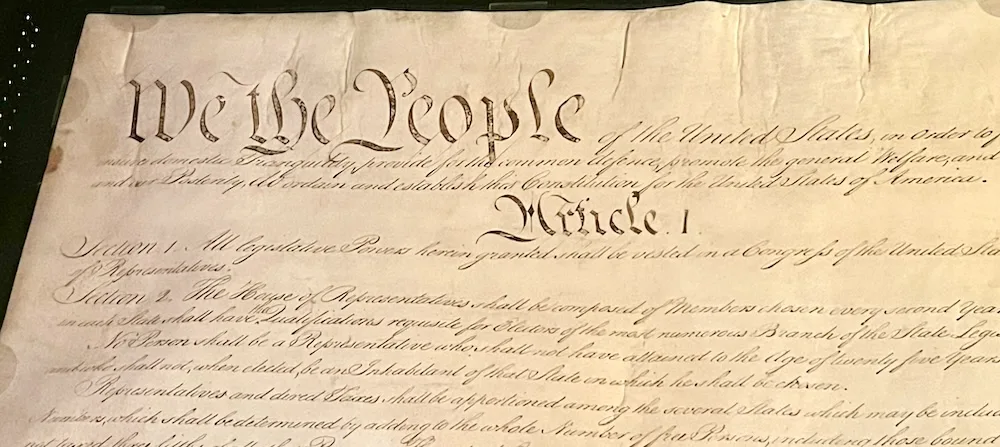
Upstairs you’ll find drafts and final versions of the Declaration of Independence, the Constitution and the Bill of Rights. They are old and faded and can be difficult to read. But pause and give your eyes a chance to adjust to the old-fashioned script and they start to get interesting.
I really liked reading George Washington’s comments on a draft of the Declaration. And an early version of the Bill of Rights had 12; only ten passed.
Generally, I think High schoolers, who have learned about these documents in-depth and can look for clauses and details they’ve read about, will get the most out of a visit here.
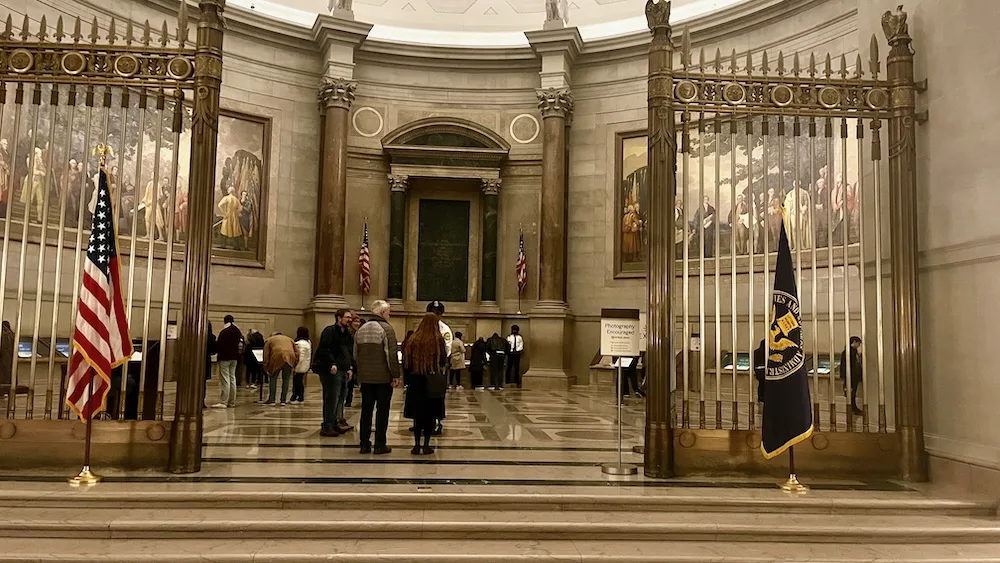
There was a security guard who was very good at engaging younger visitors (top). He thrilled a few kids by explaining that parchment is made from animal skin and it gets wrinkly when it ages, just like people do. They made beelines to the cases to check this out (so did I). But otherwise, the school-age kids all looked a little bored and unsure what to do with themselves.
You can usually get free walk-in tickets here, but if you get the free timed-entry tickets ahead of time you’ll get in more quickly. There’s airport-style security here as well.
Visiting the Monuments
I think the Vietnam and Korean War Memorials are very moving, each in their own way. Teenagers should get to see them. And the Lincoln and Jefferson Memorials are obligatory for a first-time visit, as much for their views as for themselves.
But the monuments are not close to each other or anything else, including any Metro stations. And it’s almost impossible to park legally around them. I think it’s worth paying for a tour that takes you around to all of them. You can see them all in much less time than it would take you on your own, and someone else can worry about the parking.
Bookstores Galore
Washington, DC is a great city for bookstores. We found used bookstores we liked in pretty much every neighborhood we explored. In addition to Capitol Hill Books, we liked Second Story Books off of Dupont Circle and Lost City Books in Adams-Morgan.
Best With Tweens & Kids
There are 19 Smithsonian museums, galleries and gardens clustered on or near the mall, plus the Zoo. Some are enormous and some are quite modest. They all have free admission.
This means, as cool and fun as they are, you don’t have to stick to the Natural History and Air and Space museums with kids. Take a no-risk flyer on the Arts & Industries Building, the National Portrait Gallery or the new Women’s History Museum. They might surprise you. Most of the museums have tools to help kids engage. And if they aren’t your thing, or your kids are bored to tears in minutes, you can walk out and try a different one.
The National Postal Museum
For example, I thought Rich and Teen Traveler were joking when they suggested going to the National Postal Museum.
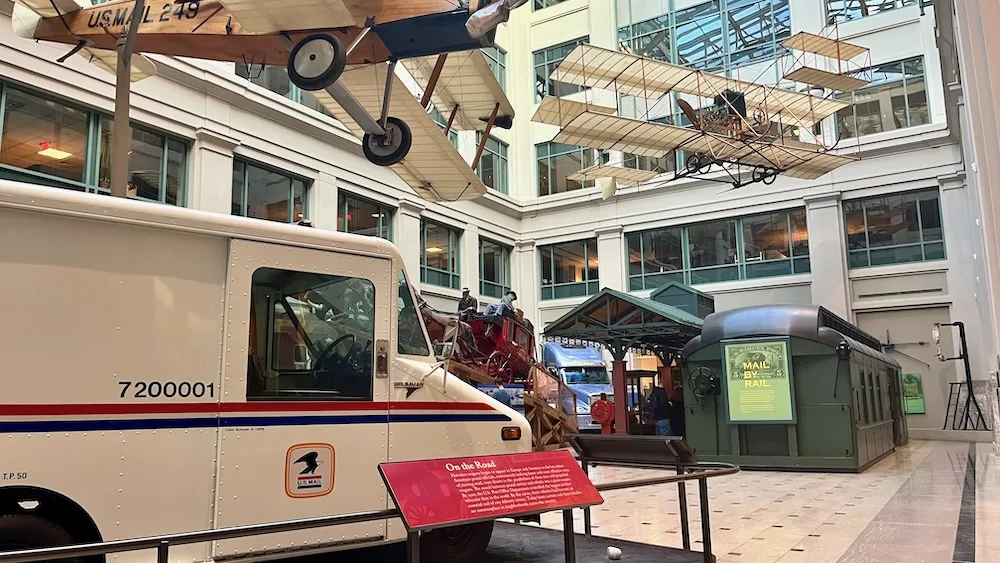
They weren’t. And it was surprisingly interesting. Upstairs they have a large stamp collection, where philatelists can admire rare stamps and notable stamp mistakes, like the “flying Jenny.”
Downstairs, the exhibits explore how mail delivery evolved as our nation expanded in the 1800s, how it impacted social connections, how technology changed the pace of delivery and how mail delivery facilitated the development of new technologies. For example, investment in airmail helped to get a fledgling commercial airline industry off the ground.
There was also an exhibit on the surprisingly large role postal inspectors play in fighting crime. We enjoyed the hour or so we spent here and came away with new knowledge of and appreciation for the U.S. Mail.
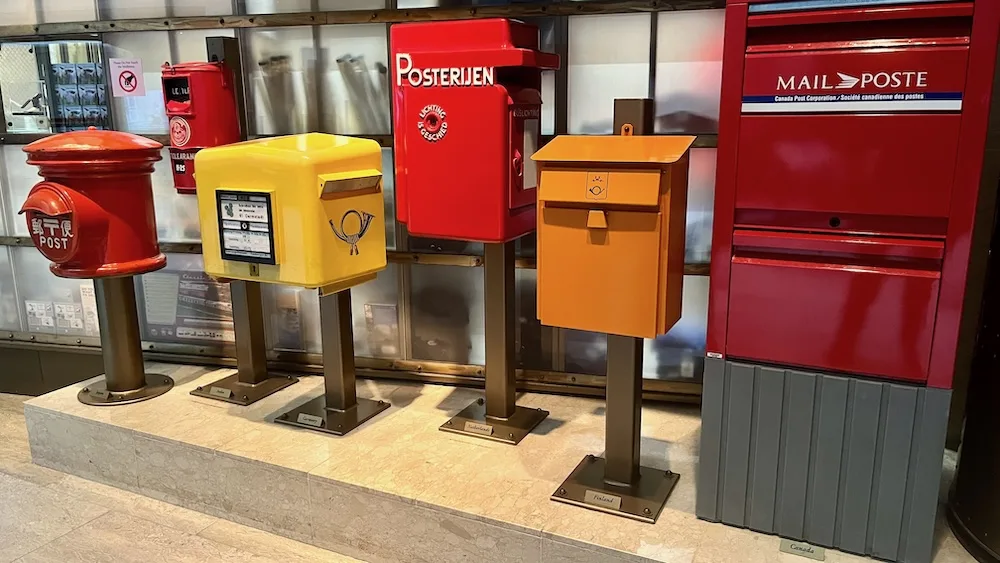
The exhibits were big and colorful, and seemed targeted toward kids. But there was a lot of reading and not as many interactive elements as there could have been. Little kids looked bored. Older elementary-school and middle-school are the ideal ages for this. Ask at the visitor’s desk for the scavenger hunt.
The Postal Museum is a Smithsonian museum and admission is located in, you guessed it, an impressive 1914 post office building on Massachusetts Ave. NE, a 15-minute walk from the Mall.
A Rainy Day at the National Building Museum
If you’ve run through the kid-friendly Smithsonian museums and need an inside day, head to the National Building Museum a few blocks away from the mall. You have to pay admission, but given how hard it was to get our elementary-school-aged kid out, it was worth it.
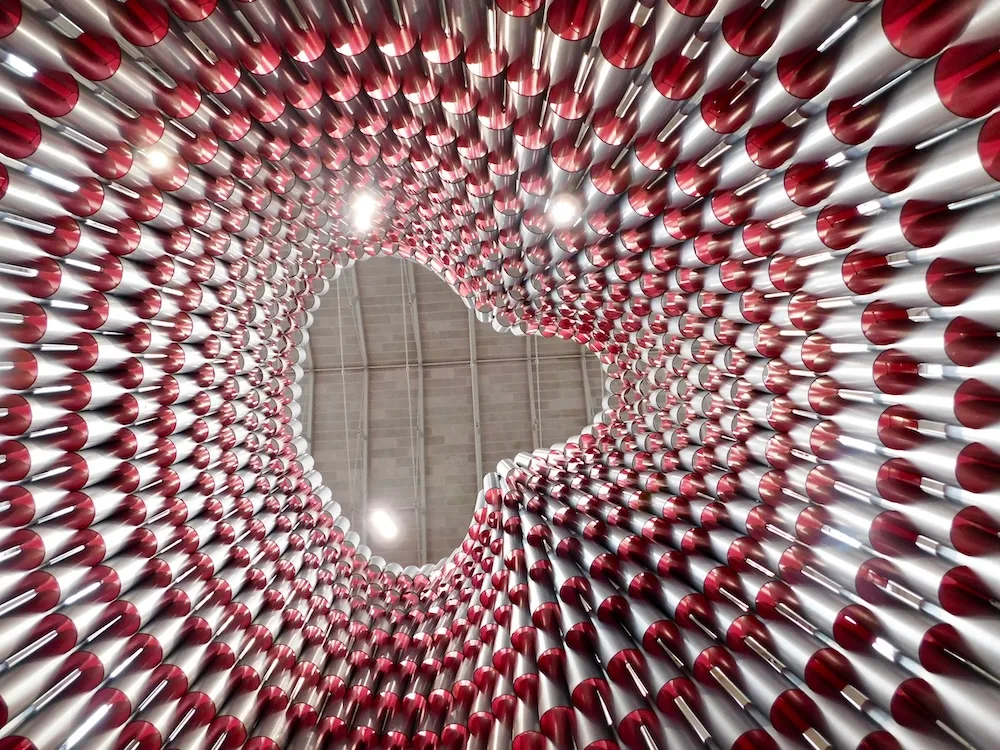
The soaring atrium, which has hosted inaugural balls, usually has some sort of large-interactive exhibit that leaves room for kids to get a little boisterous.
Almost all of the exhibits change constantly. Some of the more kid-friendly ones have included a mini-golf course designed by architects, several Leg-related displays and activities, a giant maze, an indoor beach and an augmented-reality immersive exhibit about Paris’ Notre Dame cathedral.
Two of the best exhibits we saw when we went were a retrospective on the American house (better for adults) and a collection of elaborate folded-paper building kits that included the Taj Mahal, Barcelona’s Sagrada Familia and the Roman Baths in England.
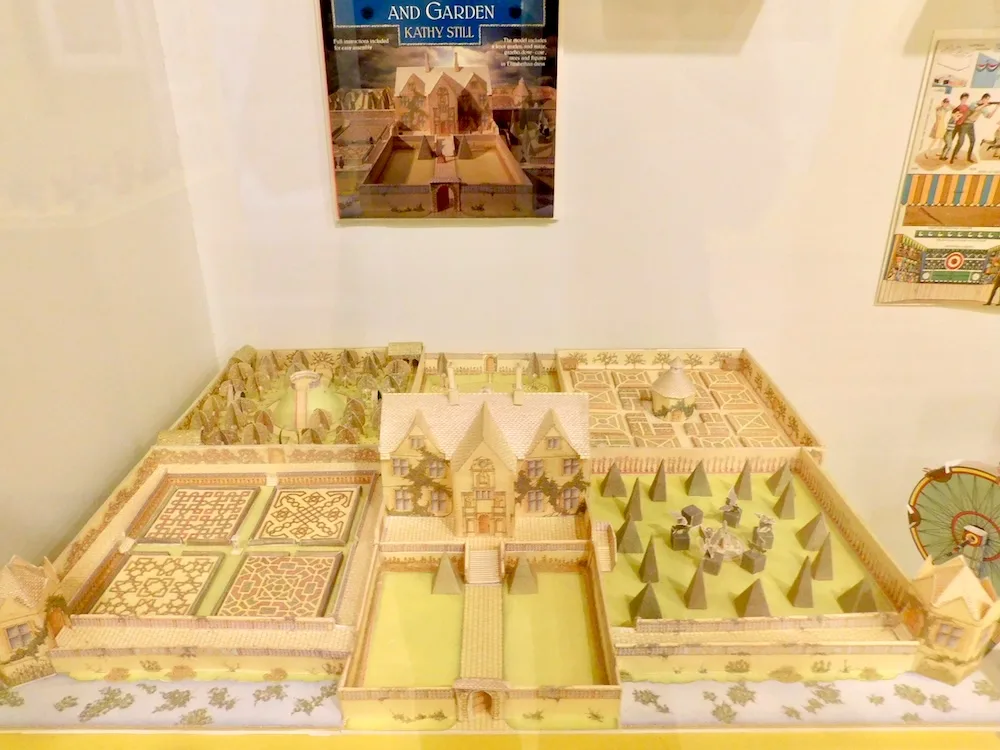
The building was originally the Civil War soldiers pension office. You can see remnants of this use in some of the rooms and the staircases scaled for wounded soldiers. If you get arrive early enough you can take a building tour.
Best With Kids and Preschoolers
Clemyjontri Park
If you have a car and kids under 10, cross the Potomac into Fairfax County and head to this impossibly huge and colorful playground.
One of the most special-needs-accessible playgrounds in the country, it offers a carousel, a maze and dozens of things for all kids to climb, swing and bounce on, along with shaded picnic pavilions for taking a break.
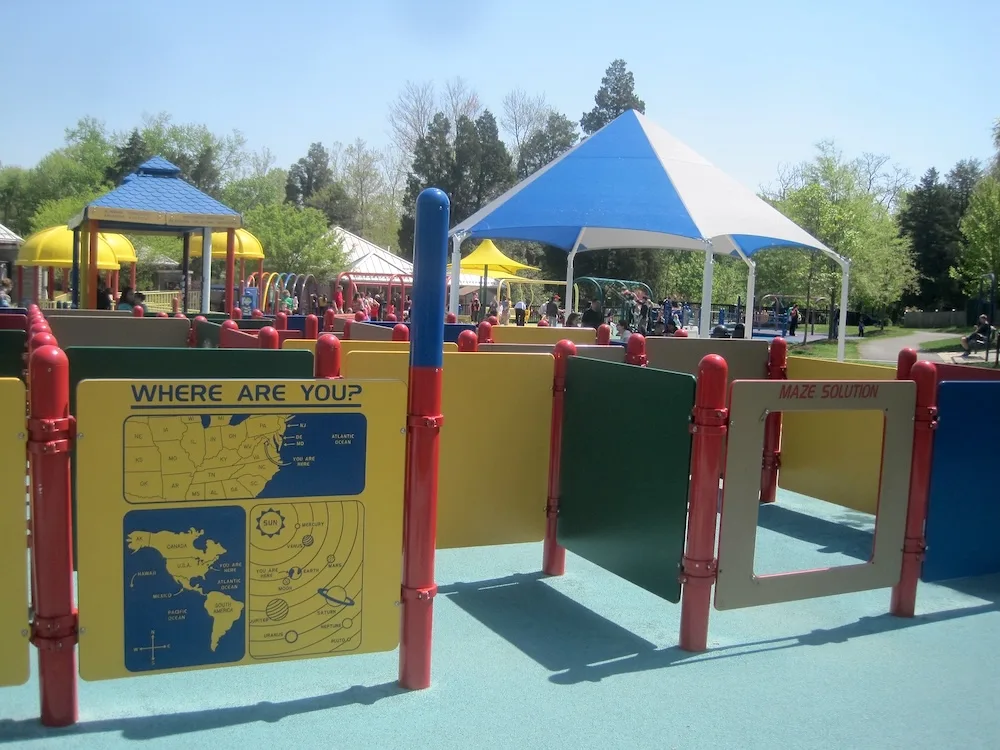
Tip: If you like good Asian food, after your playground jaunt, head to Eden Center, a strip mall filled entirely with Vietnamese restaurants, bakeries, grocery stores and shops about 20 minutes away in Falls Church. Options range from bubble tea and banh mi (Vietnamese sandwiches) to quick noodle dishes and elaborate seafood dinners.
The Hirshhorn Museum & Sculpture Garden
A contemporary art museum with kids? Yes. We saw works ranging from large Andy Warhol paintings to a giant mobile made from dry-cleaner hangers.
Even if you aren’t a fan of this type of art, there are always collections or pieces here that are colorful, eccentric, clever or bewildering. And kids’ reactions to all of it are usually instant and unrestrained.
At 5YO, Tiny Traveler took one look at the coat hangers, turned on her heel dismissively and set off to see what else there was to see.
She liked the Warhols and decided some small colorful doodles on a black background looked like scratch art (they totally did).
Ask at the Welcome Desk if they have activity guides for any of the current exhibits.
Great For All Ages
The Museum of American History
The Smithsonian’s American History Museum is most people’s favorite. It’s huge. You can’t see it all in one day. And we usually get museumed-out after about two hours. There is something for every age and every interest among the permanent and rotating exhibitions.
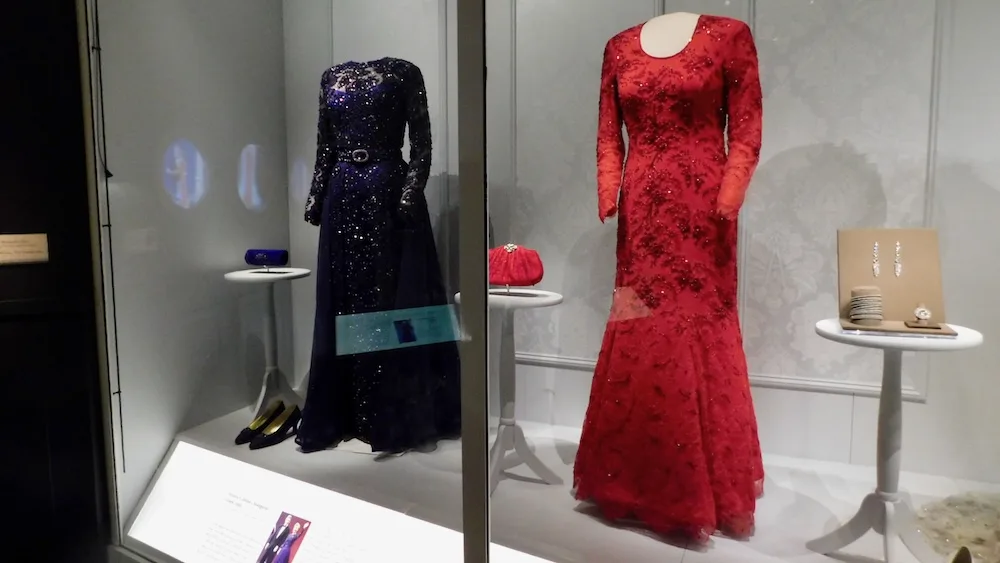
Look at the Greensboro lunch counter, the enormous and tattered American flag that inspired “The Star-Spangled Banner,” 90 years of American lunch boxes and a collection of First Lady’s dresses from the Martha Washington’s to Michelle Obama’s.
There are two interactive spaces for elementary and school-age kids and a separate hands-on space for kids under 6YO.
Some of the more unique exhibits include a partially reconstructed New England house that tells the history of five families that lived in it over two centuries. One gallery on the history of American democracy and another that explore how American food has changed over the past 80 years are thought-provoking in different ways.
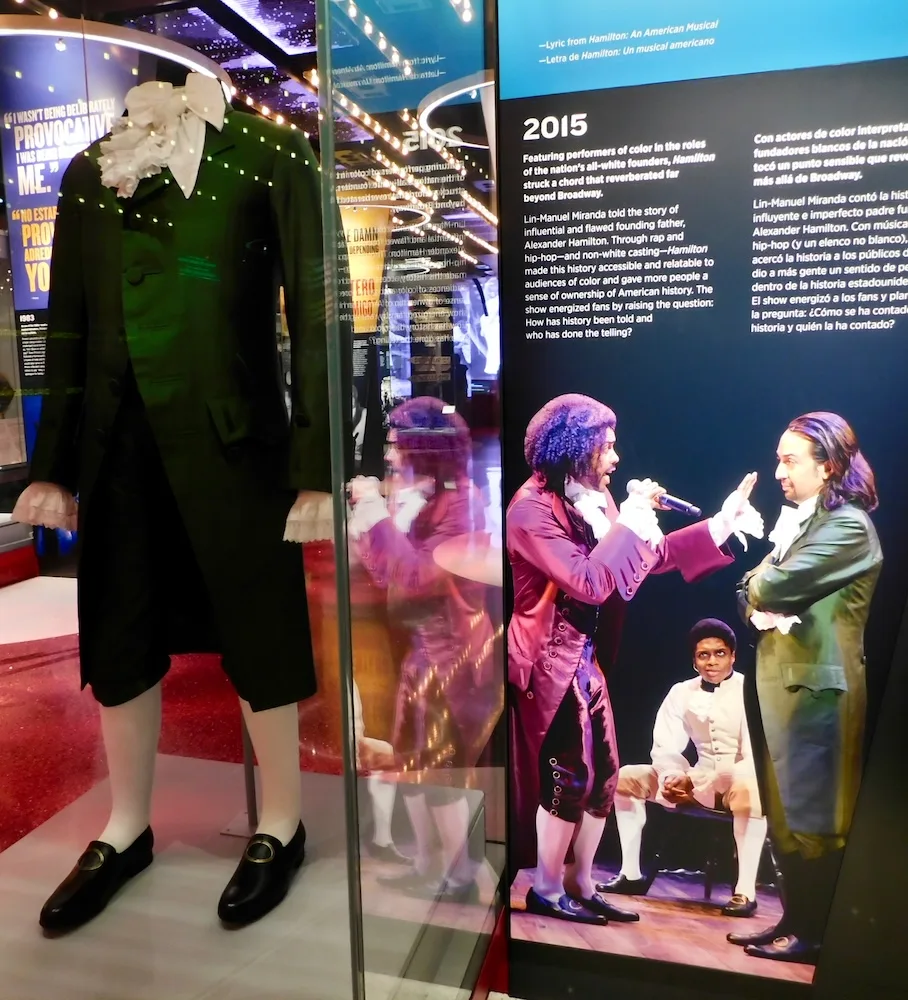
Entertainment Nation is the museum’s famous collection of American pop culture artifacts. They’re always adding new items, like costumes from Hamilton.
Everyone likes seeing C3PO and Kermit the Frog. But In truth, I think parents always enjoy this exhibit more than kids who don’t get why Anton Ono’s gold skates, Prince’s guitar or the signpost from MASH are totally cool.
If your kids needs someplace to cut loose and be kids, head downstairs to the Wonderplace with kids under 6YO and to Sparklab with 6YO to 12YOs.
The Museum of the Department of the Interior
If you have time to kill around the mall, stop in to the Department of the Interior, which oversees our National Parks, Monuments and Wildlife Preserves, among other things. It has a small museum that takes less than 45 minutes to explore and that is something of a hidden gem. Chances are good you’ll have it all to yourself, which is in itself kind of cool.
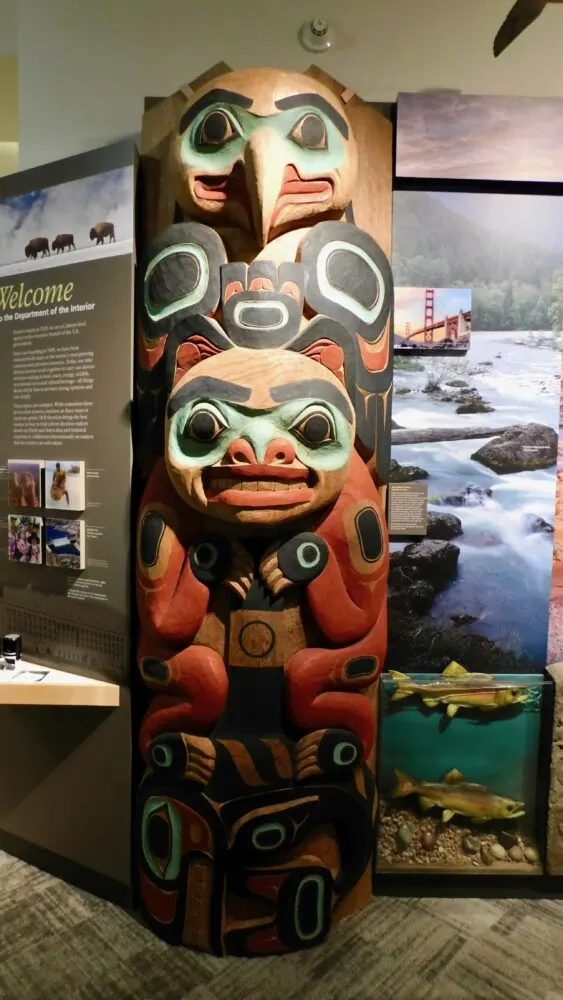
The museum was created when the Department of the Interior got a new building in the 1930s. The Secretary of the Interior at the time thought it would help citizens to understand and appreciate what the sprawling Department of the Interior does.
The coolest things we saw were a set of four large paintings by photographer and artist William Henry Jackson, celebrating the major land surveys the government did out west in the late 19th century.
He shows sets the basic camps and day-to-day work of the surveying teams against the stunning landscapes that would become some of our most famous national parks. They’re paintings made with a photographer’s eye and were unique.
There are also daily tours of the building, where you can see a treasure trove of public works-era murals throughout the building. It’s free and takes a bit more than an hour. Next time we’re in D.C. I plan to make time for this. Seems likely to be another hidden gem.
Smithsonian Folklife Festival
This world culture festival takes over the mall for ten days in June and July and is one of the biggest annual events in Washington, DC.
Each year it celebrates a country or theme with music, dancing, food, crafts and educational activities. The year we went they were celebrating Hungary. In 2024 the focus was on indigenous voices across the Americas.
In 2025 the festival will celebrate youth and explore the future of culture. And in 2026 it will celebrate the United States’ 250th birthday.
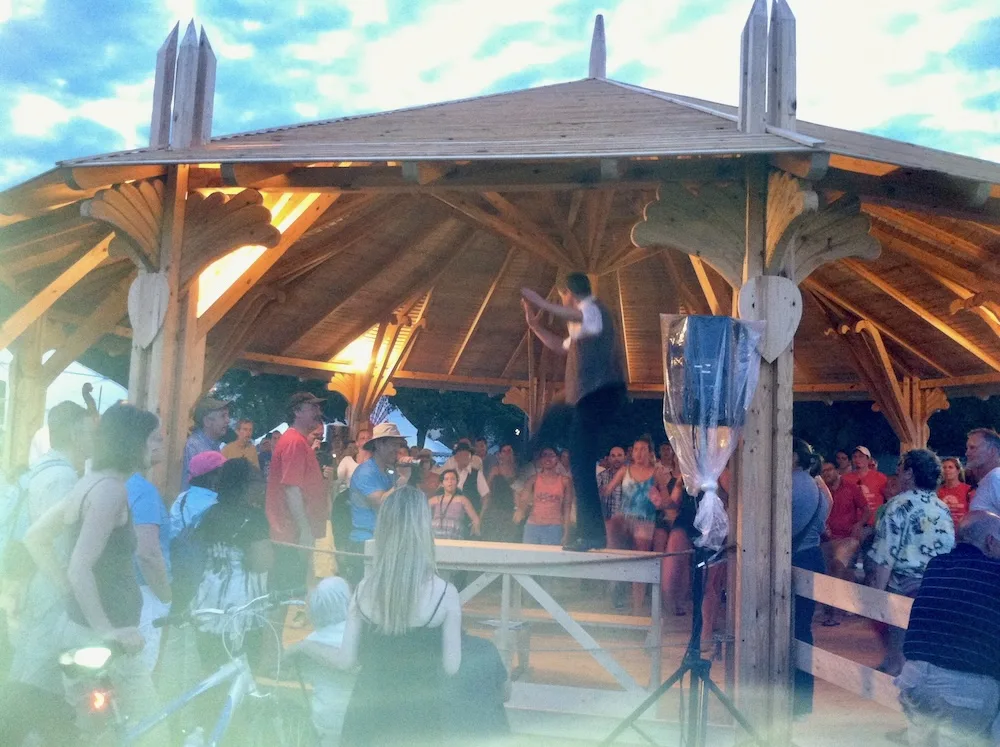
There is a main tent as well as smaller venues with music, storytelling, crafts, fashion and family activities. No matter the theme, the food stalls are from around the world. We saw Indian, Native American, Latino, Hungarian and American soul-food stalls and a Hungarian beer tent.
The food stalls and main tent stay open until about 9:30 p.m. We got a lesson in Hungarian folk dancing after dinner one evening, But the other activities wind down by 5:00 or 6:00. This is a shame because the Mall is blazing hot on summer days and it’s far more enjoyable to be there in the evening.
Saturday Morning in Alexandria
We sometimes stay in Alexandria because we love its pedestrian friendly main drag, especially on Saturday mornings.
We start those mornings at the farmer’s market on King and S. Royal streets. In the warm months it’s bursting with local produce, baked goods, shoppers and street musicians.
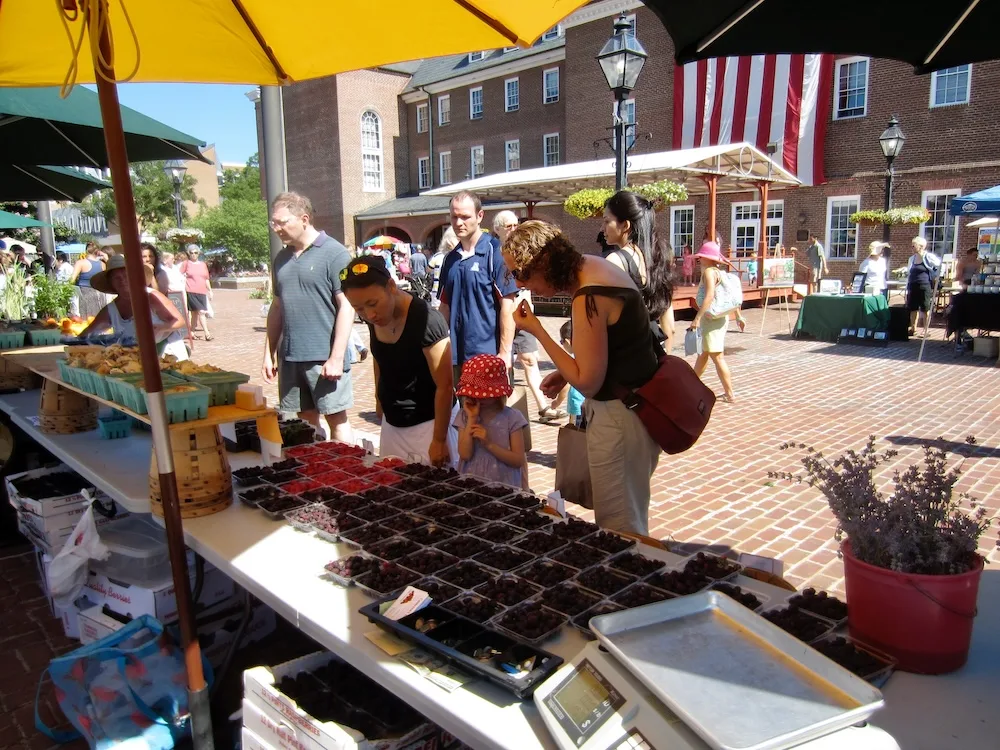
We bought ham biscuits, black and red raspberries (black and red) and mini cherry pies to eat on the spot for breakfast. And we picked up peaches, tomatoes and salty southern style ham to bring home.
After the market, we head toward the water to explore the Torpedo Factory, a gallery space full of colorful art and crafts including print-making, ceramics and enamel jewelry design. You might even see the artists at work.
On the 3rd floor you’ll find the tiny Alexandria Archeology Museum. They let smaller visitors play archeologist with activities like piecing together shards of broken pottery.
Behind the factory is a grassy waterside park where kids can run around and feed ducks.
There are restaurants and shops, including a good independent book store, all along King Street and the waterfront. Places we’ve liked have come and gone, but we usually can find someplace that looks good and isn’t too packed.
Virtue Feed & Grain, is in a big space near the water. It has a good beer selection, well-done bar snacks and appetizers and root beer floats. It feels more family friendly than some of the other area pubs.
Union Street Public House is a more upscale pub specializing in seafood. It’s the place to go when you want a cocktail and nice meal in a place that’s relatively kid friendly.
Tip: A free trolley runs the length of King Street from the waterfront to the Metro station.
Eating In and Around Washington, DC With Kids
Where to Eat on the Mall
As wonderful as the National Mall is, the museums and government buildings around it sprawl quite a bit. And finding a convenient, quick meal isn’t easy.
There are food trucks around the mall but they tended to be very overpriced (one was charging $6 for a hot dog).
Also, If you buy lunch from any of them, don’t pay until they hand you your meal. They’re almost all parked illegally and if they spot any police nearby they close down and drive off in a flash. We ordered from one parked on a 7th St. and when one of his colleagues spotted a police car he shut down and drove off without finishing our order!
Here are a couple of places on or just off the mall that were handy, with good food at reasonable prices.
Museum of the American Indian
The much-praised Mitsitam Café at the Museum of the American Indian reopened in spring of 2024 after a major revamp. Dishes feature foods native to the Americas, so look for items with corn, potatoes, tomatoes and hatch chiles.
Fry bread and buffalo burgers are likely to please the kiddos. You can try southwest lamb stew or wild rice cakes with smoked candied salmon.
It’s still a museum-cafeteria, but the food is fresh and healthy (aside from the fry bread) and it’s a change from the usual museum café salad or turkey wrap.
For breakfast or a quick snack, the museum also has an espresso bar that features hatch chili corn muffins, posole and wild-rice salad along with sandwiches and pastries.
The USDA Cafeteria, Really.
In need of breakfast near the Mall one morning, I asked a Smithsonian employee what was nearby and he steered me to the USDA employee cafeteria on C street near 12 St. SW.
I was intrigued and quite pleased to discover this healthy and inexpensive food court. It has since gotten a makeover that has expanded the food offerings.
So look for more options and international flavors now. You’ll find burritos and Chinese noodles at lunchtime. But there are no trans fats anywhere and lots of options to put fruit and vegetables on your kid’s plate. There are also nutrition labels on everything so, for better or for worse, you know exactly what you’re eating.
It’s open from 7:00 -2:00 on weekdays. You do have to pass through a metal detector and bag check to come in. But prices are subsidized, so you can put together a good size plate of food for lunch for less than $10, and even less than that at breakfast.
Tip: On Fridays from June to October the USDA also runs a farmers’ market across from the mall on 12th St. SW. With produce, sweet and savory baked goods, pickles and locally cured olives from some 30 local farmers and purveyors, it’s a good place to stock up for a picnic on the Mall.
Finding Good Food Further Afield
Eastern Market
Teen Traveler read about Eastern Market and insisted we head there for lunch on the Saturday we arrived in town.
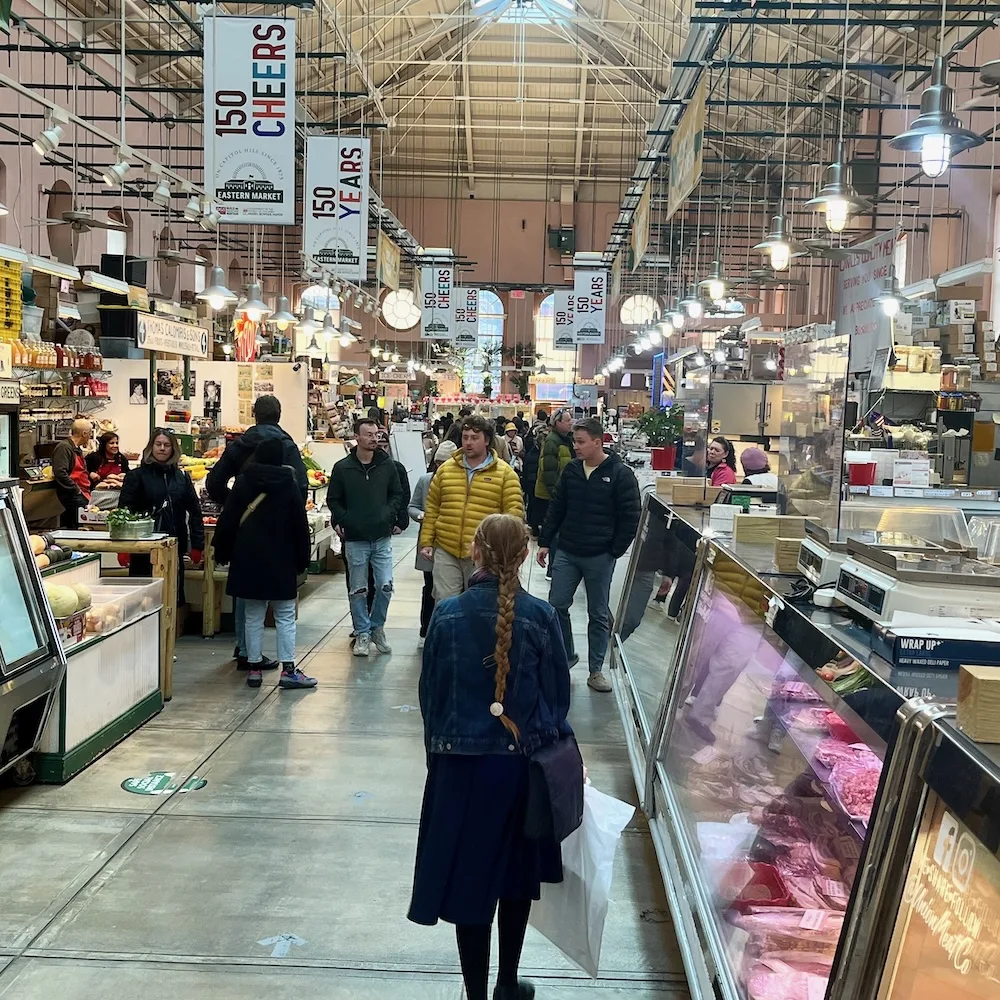
More than a half dozen trucks and stalls sit outside of the market serving up Thai, Middle Eastern, Jamaican, Filipino food and more. We shared plates of soul food that included creamy baked macaroni & cheese and stewed chicken that fell off the bone. It was very, very good.
Even on a February day the market-area was busy; I imagine there are more vendors and more people in the spring and fall. While other tourists no doubt find our way there, it had had a nice local, neighborhood vibe.
The market’s main indoor space has vendors selling meat, fish, dairy and produce and some prepared foods.
Alongside the market building on 7th St SE are permanent stalls with more food and fresh produce and a slew of local artisans.
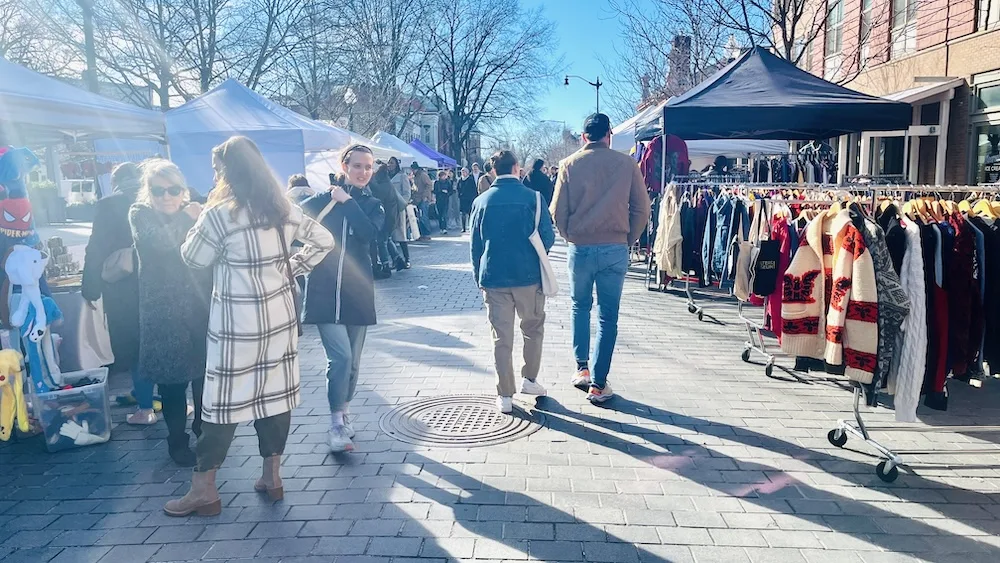
There are more vendors and restaurants one block back from the market on C St SW. This is where we found Moorenko’s, a local ice cream place with terrific flavors.
I went for wild blueberry; Rich chose butter pecan and Teen Traveler went for the cookie overload. The store has interesting flavors without being too esoteric. I’d go back to try the white chocolate mint, Swiss chocolate, cinnamon cappuccino or blackberry chocolate chip.
Capitol Hill Books is a used bookstore on C St SE across from the market building. This discovery made our afternoon at the market just about perfect.
The market is a 15-minute walk or one Metro stop from the Capitol. It’s open from Tuesday to Sunday and is busiest on Tuesday, when there is a farmers’ market, and on the weekends when the whole area is lively with shoppers, diners, vendors and buskers.
Immigrant Food
The casual world-fusion restaurants has a few outlets around town; we ate at the one underneath Word Planet.
The restaurant has has a friendly staff and fun menu full of shareable plates. We have Fililipino fried chicke with Belgian fries and charred Brussels sprouts. The Asian cauliflower with kim chi, Greek wings and polenta fries were also tempting.
We walked in before 6:30 and caught the weekend happy hour, which means we got a discount on some of our plates and on my Amalfi Sprits cocktail. That would have been enough reason to try it but, the staff wear shirts that say, “Immigrants make America great,” which totally won us over.
Jaleo by José Andrés for Downtown Dinner
We had eaten at Jaleo when we were in Las Vegas and it was a surprising hit with Teen Traveler, especially the creamy-crunchy chicken croquettes. Andrés does a lot of very good charity work, too, so it was an easy decision to eat at his original restaurant in downtown D.C.
It’s the sort of stylish, always-hopping place where the service could be rushed and snooty. It was especially busy the night we walked in because of a hockey game at nearby Capitol One Arena.
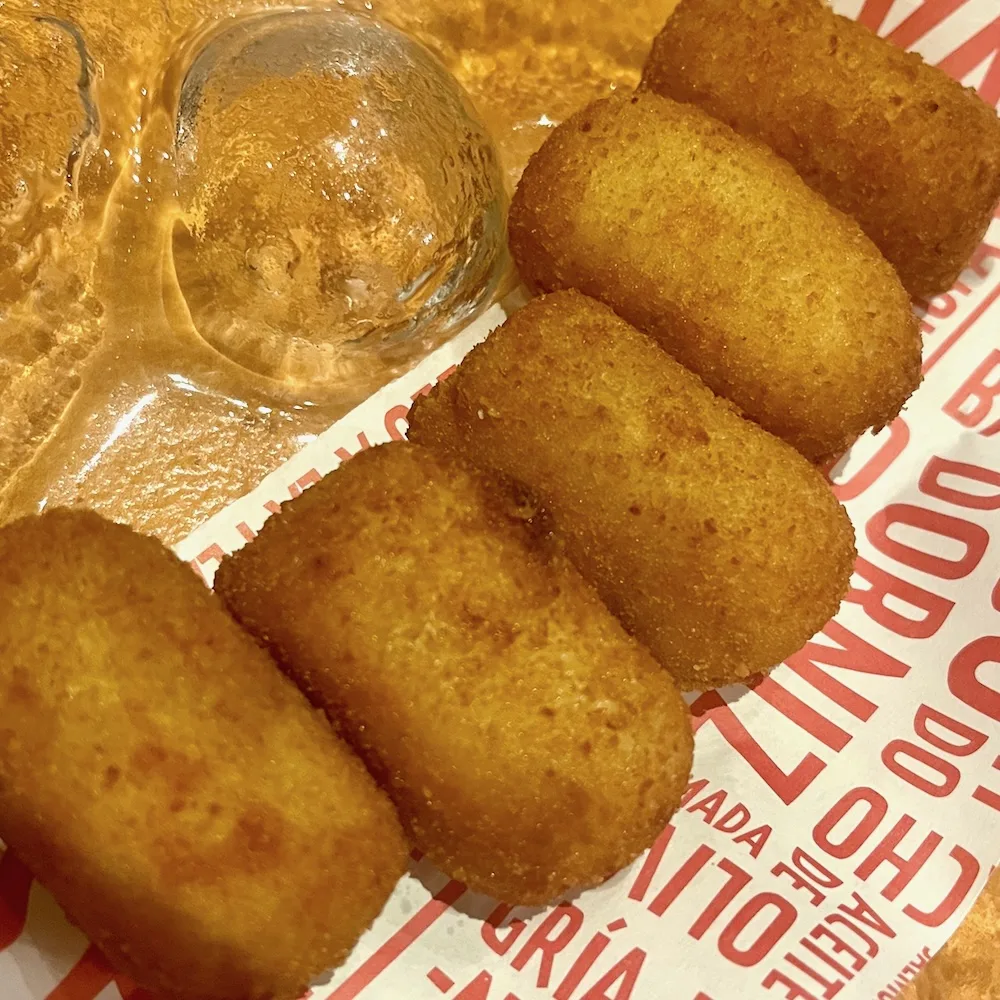
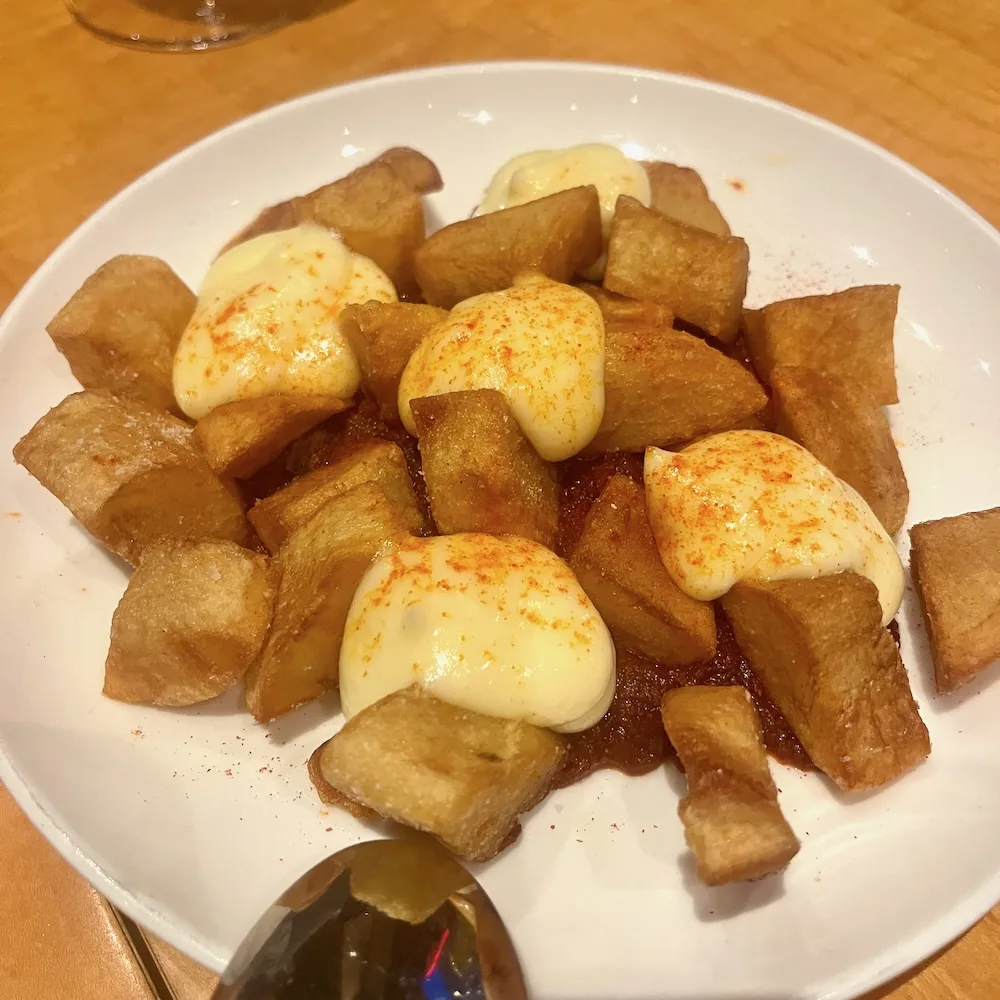
But they found us a table amid the hockey fans and area office workers there for happy hour. The service was friendly and definitely not rushed.
In addition to the croquettes, the potato tortilla, patatas bravas (pan-friend potatoes served with garlicy aioli), fried calamari and shrimps in garlic are safe bets with our teen.
Rich and I usually add a vegetable or salad to the mix of shared plates and order one of the several types of sangria.
The only thing missing were the churros with chocolate sauce that we had in Vegas. The dessert menu here is a little esoteric and we skipped it.
Two West-End Options
We stayed in the west end, roughly halfway between Foggy Bottom and Dupont Circle. We weren’t in the prime shopping-and-dining area for either neighborhood. But we found a few gems not far from the hotel.
Soi 38 felt like a Thai Diner. It was another place where it was common to share a bunch of dishes, so it was perfect for us. It wasn’t your usual Thai restaurant and there were a lot of dishes and flavors on the menu that we haven’t seen everywhere.
We ordered fried tofu, always a favorite, and then tried crispy roast duck with Chinese broccoli and roasted pork belly. It was all very good. And the tab was very reasonable.
On out last night we were heading toward Dupont Circle when we walked past Giovanni’s Trattú, an Italian restaurant that was slightly below street level and looked equal cozy and friendly.
Inside, it had a neighborhood vibe and good Italian standards at reasonable prices. We loved our warm, crusty garlic bread. And happily tucked in to lasagna, veal tortellini and eggplant parm.
They had tiramisu, which none of us can resist. So we shared dessert.
One of the best features of the hotel we chose was its proximity to a Tatte Bakery & Café, a Boston chain we like just up the block, where M St and New Hampshire Ave NW cross. They always have a large selection of breakfast pastries, croissants, Jerusalem bagels and more, so we could order something new every day.
We learned to order our coffee and egg sandwiches ahead on their app though, because it was usually busy in the morning and the prepared food and lattes could take a while.
Ending with a Sweet Georgetown Treat
After touring Georgetown University and eating a somewhat overpriced lunch in a Wisconsin Avenue pub, we stumbled upon Georgetown Cupcakes, at M and 33rd streets NW. It was a great find.
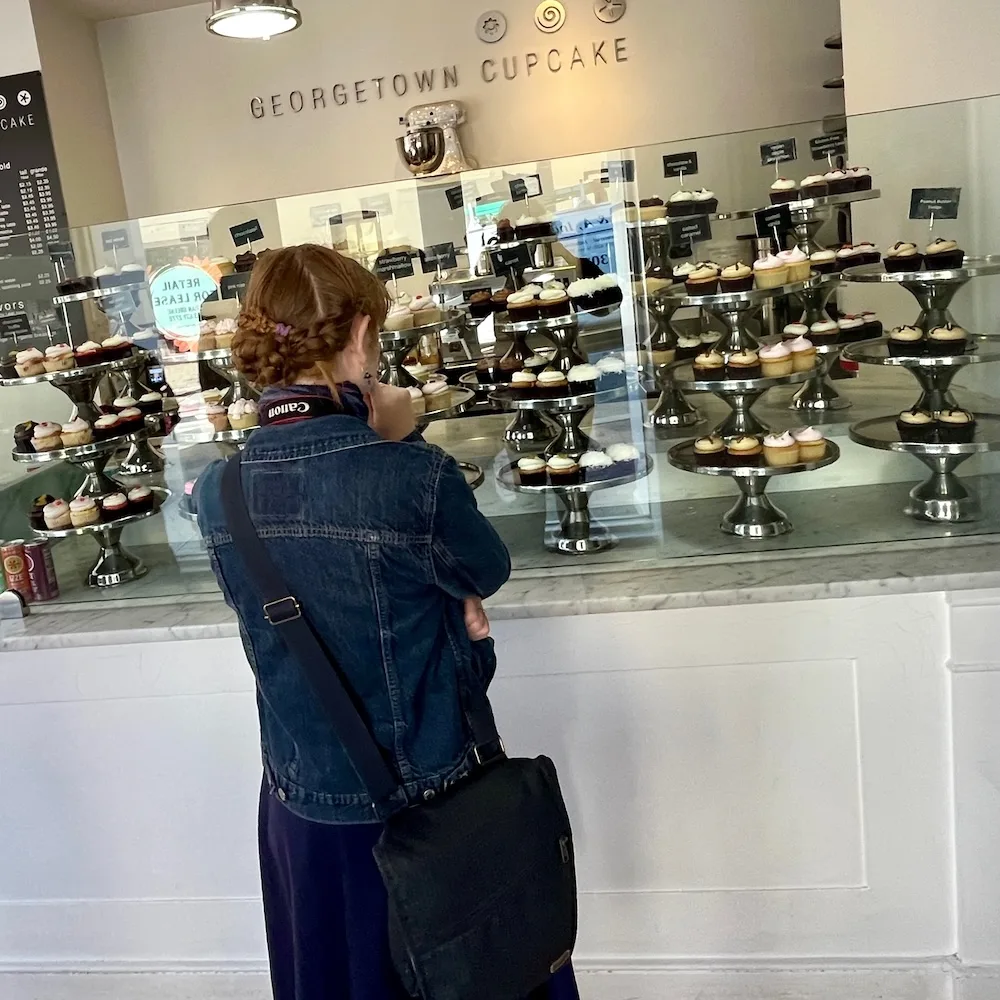
It’s a bright shop with attractive and colorful displays of cupcakes in a plethora of flavors. They have moist cake and a good ratio of cake to icing. And they’re too small to share, which I see as a good thing.
They have standard vanilla and chocolate cupcakes along with many rotating flavors. I had a chocolate coconut cupcake, a daily special, and Teen Traveler had a chocolate raspberry cupcake, one of several February cupcakes that were red or pink for Valentine’s Day.
Pin it for later!
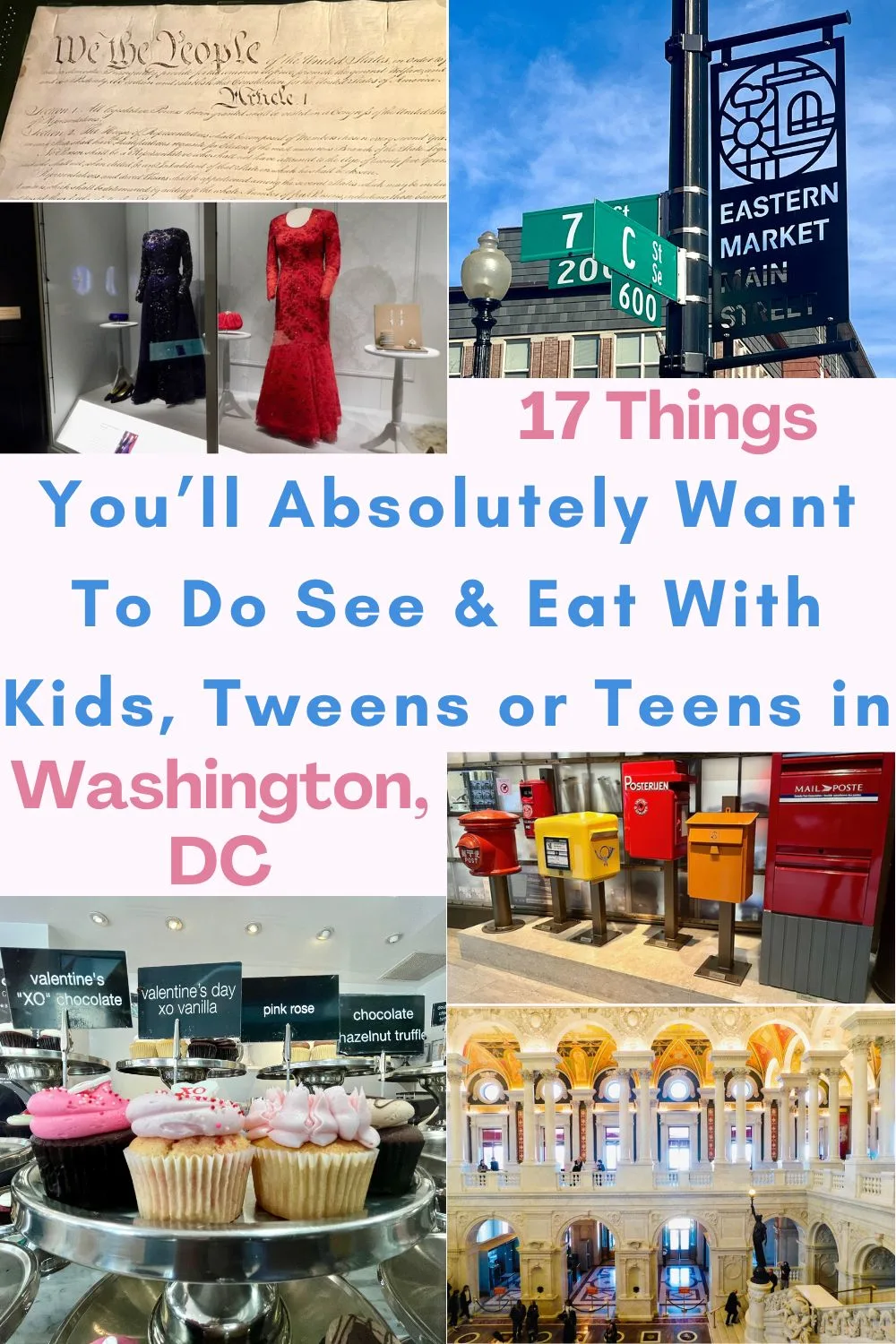
All photos by FamiliesGo!© except Clemyjontri (Andrew Watson via Flickr)

